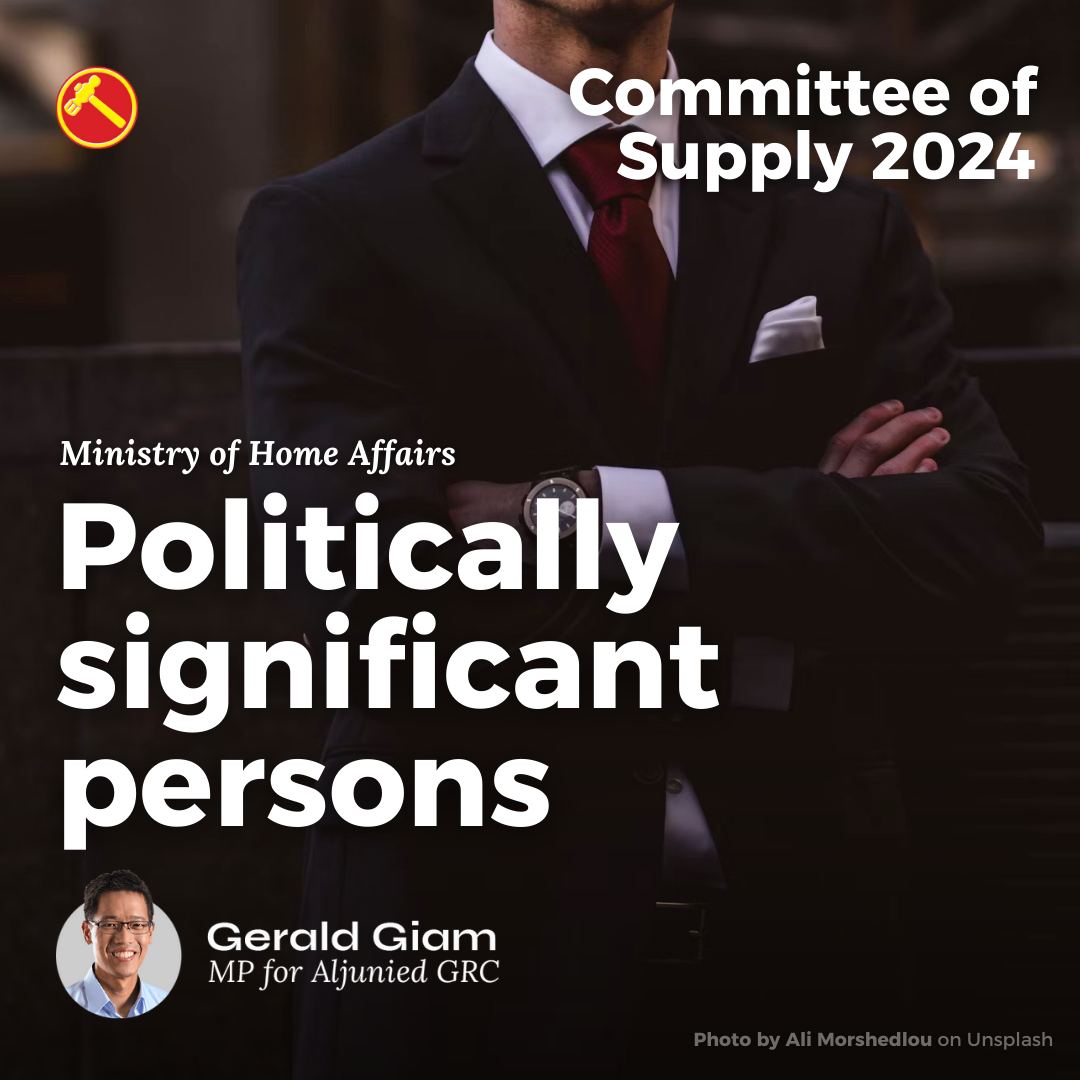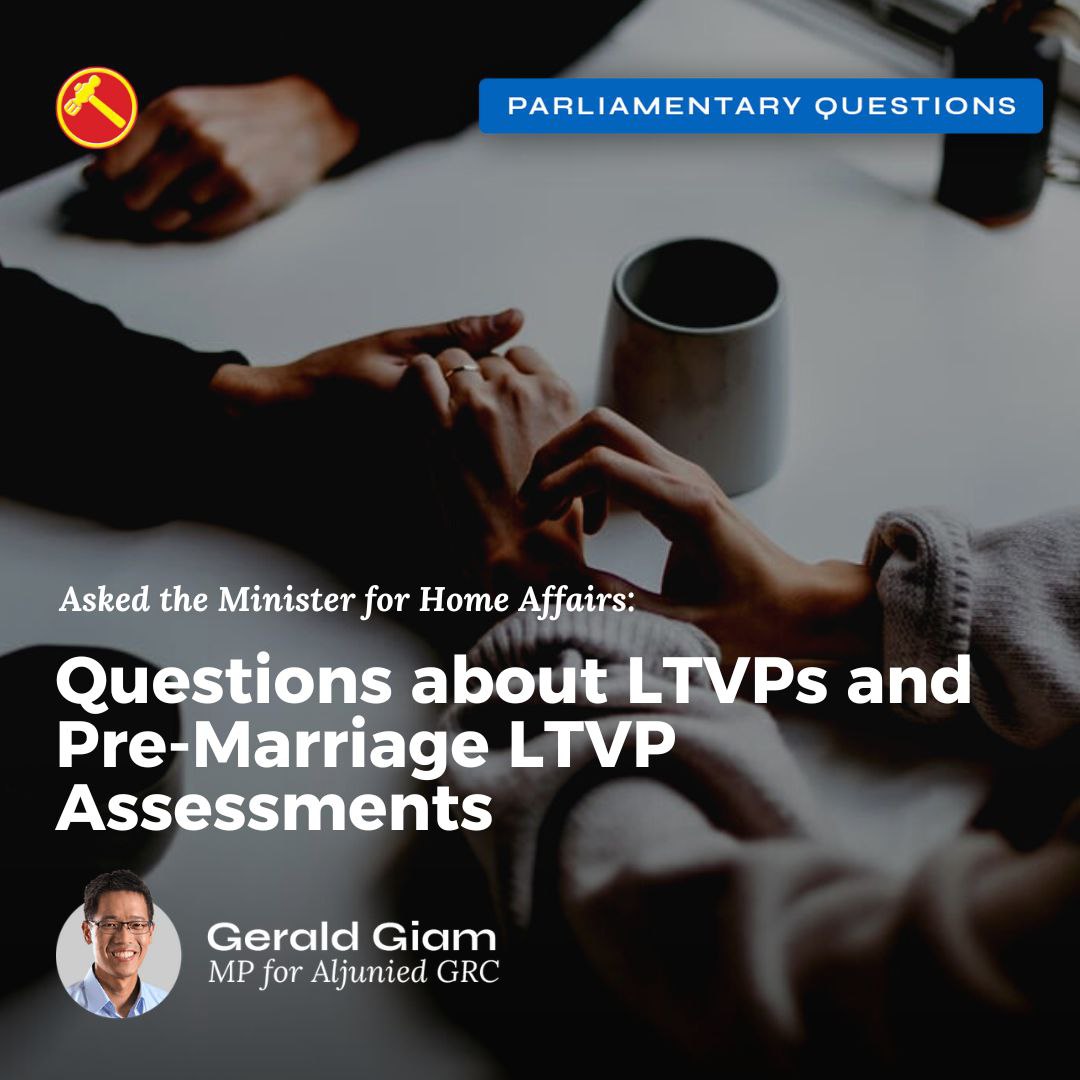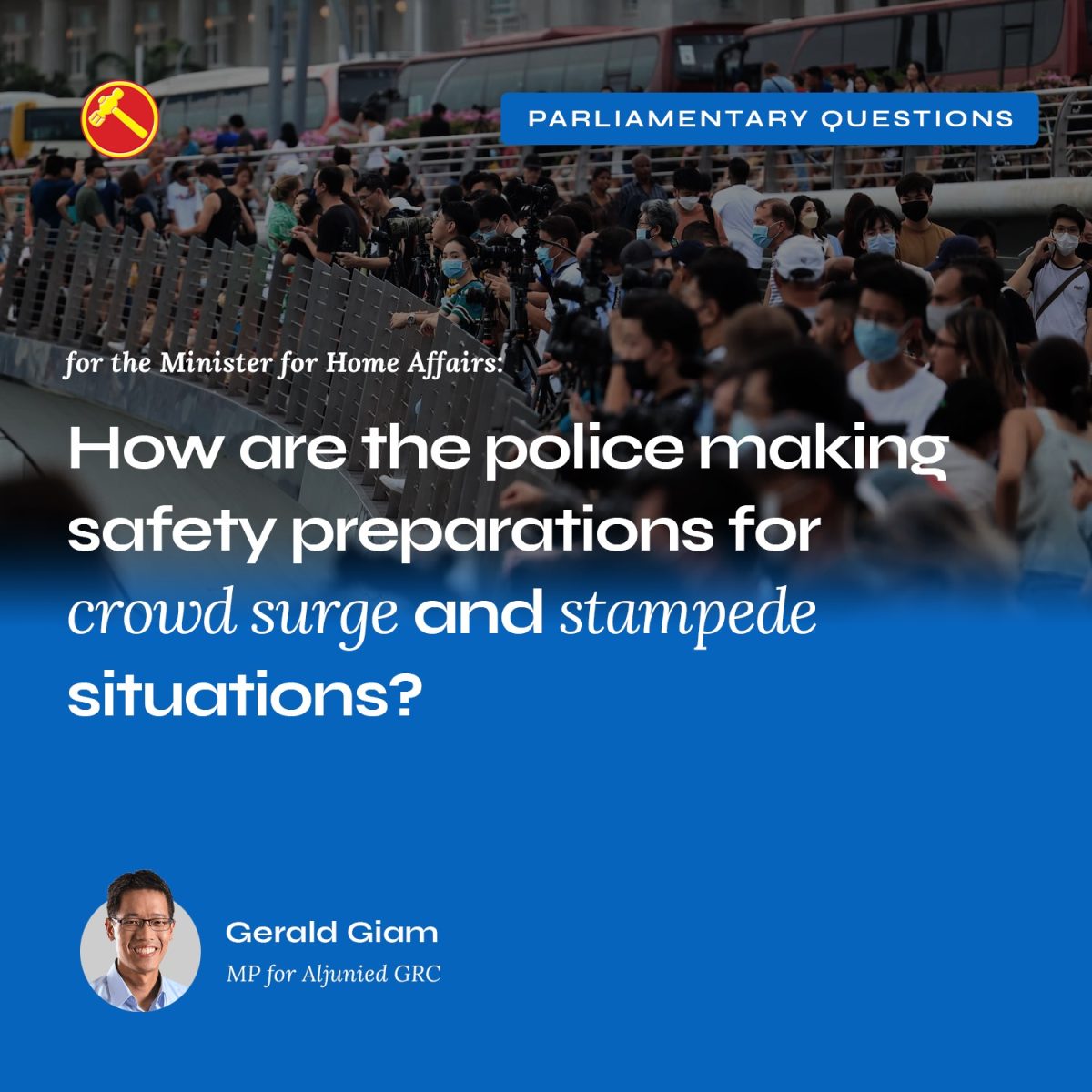I asked the Minister for Home Affairs these questions in Parliament on 12 August 2013 regarding the death of prison inmate Dinesh Raman in September 2010.
———————–
12 Mr Ang Wei Neng asked the Deputy Prime Minister and Minister for Home Affairs in light of the recent case where a senior prison officer was convicted of causing the death of an inmate by a negligent act (a) whether the deceased’s next-of-kin will be compensated and, if so, how will they be compensated; and (b) whether there was a delay in the investigation process given that the senior prison officer was charged in court almost three years after the inmate’s death.
13 Mr Gerald Giam Yean Song asked the Deputy Prime Minister and Minister for Home Affairs (a) whether the Singapore Prison Service’s restraining methods on inmates pose a continuing risk of fatal or permanent injury; and (b) whether there have been any changes to the restraining methods following the death of an inmate due to positional asphyxia.
14 Mr Pritam Singh asked the Deputy Prime Minister and Minister for Home Affairs regarding the recent case where a senior prison officer is convicted of causing the death of an inmate by a negligent act, why is the Ministry’s Committee of Inquiry looking into the circumstances surrounding the inmate’s death which occurred in September 2010 only able to submit its report in June 2013.
The Second Minister for Home Affairs (Mr S Iswaran) (for the Deputy Prime Minister and Minister for Home Affairs) : Mdm Speaker, may I have your permission to take questions 12, 13 and 14 together.
Mdm Speaker : Yes, please.
Mr S Iswaran : Madam, all three questions concern the unfortunate death of a prison inmate, Dinesh Raman s/o Chinnaiah, who passed away on 27 September 2010 after he was restrained and relocated to a cell, following his unprovoked attack on a prison officer.
Madam, every case of death in prisons is taken seriously. Apart from the Singapore Prison Service’s own investigations, the Police conducts independent criminal investigations to establish the circumstances and cause of death; determine whether any criminal offences have been committed; and identify the persons responsible for the incident. The Police’s investigation findings and recommendations are then submitted to the Attorney-General’s Chambers (AGC) to consider whether prosecutorial action is to be taken.
In addition to the Police’s criminal investigations, my Ministry will thoroughly review the incident, especially the actions of all parties involved, and the appropriateness of protocols and processes adopted by the Singapore Prison Service (Prison Service). Our aim is to ensure the safety and security of inmates and prison officers, and to maintain the integrity of our prison system of strict discipline and order.
Madam, let me first set out the timeline of events to put the incident, and the actions that followed, in perspective.
Prison Service reported Dinesh Raman’s death to my Ministry on 27 September 2010, the same day of the incident. Police commenced criminal investigations immediately. Separately, the Prison Service reviewed their processes and procedures for the use of Control & Restraint (C&R) techniques. The prison officers directly involved in the incident were redeployed from operational to staff duties, pending the outcome of investigations. The Police completed its preliminary investigations and referred its findings to the Coroner, who convened a Mention session on 4 November 2010. The Coroner’s Mention formally commences a public inquiry into the circumstances of a death.
On 17 August 2012, the Police submitted its consolidated findings to AGC. On 4 February 2013, after reviewing the findings and further clarification with the Police, AGC decided to take prosecutorial action.
On 1 March 2013, the Police informed Minister for Home Affairs that the investigations had been completed. After being briefed by the Police on its findings, the Minister decided to appoint a Committee of Inquiry (COI) to conduct an independent audit of Prisons’ broader systems, processes and protocols for bringing violent inmates under control. On 4 June 2013, Minister for Home Affairs accepted the findings and recommendations of the Committee of Inquiry and directed Prison Service to implement them immediately. All the recommendations have since been implemented, or are in the process of being completed.
The charge against a Senior Prisons Officer, who was the direct supervising officer of the incident, was heard in court on 19 July 2013. DSP Lim Kwo Yin pleaded guilty to the charge of Causing Death by a Negligent Act and was fined $10,000.
Madam, it took 28 months from the commencement of Police investigations to the Attorney General’s decision to prosecute. This was due to the complexity of the case. Let me elaborate.
The police investigations included a thorough study of the Control & Restraint doctrine, training, protocols and techniques used in prison; it entailed meeting external experts, both domestic and international, to seek professional views and an assessment on the C&R techniques deployed; and it involved interviews with 130 witnesses comprising 72 prison inmates, 23 prison officers, eight prison medical staff, seven police officers, two CISCO officers and Dinesh Raman’s next-of-kin. In total, the Police conducted 144 interviews. Police investigators also went to the United Kingdom to consult a C&R expert from the National Tactical Response Group, under the UK Ministry of Justice.
In comparison, the recent Shane Todd case, which took 13 months for the State Coroner to reach a verdict, involved 60 witnesses. That case did not involve criminal charges. Another example is the Yishun Triple Murder case of 19 September 2008, which concluded with a conviction four years later on 20 November 2012, and that involved 68 witnesses.
Madam, the prison environment is complex, and the risk of security incidents is real and present. Strict discipline and control is essential to maintain a safe and secure environment, for both inmates and prison officers. While the number of violent incidents in our prisons is low when compared with other jurisdictions, they do happen. Last year, there were 61 assaults by inmates, 40 of which were against other inmates and 21 against prison officers. We have zero tolerance for any violence or abuse that could adversely affect order and discipline in our prisons because it is the foundation for the effective rehabilitation of inmates.
To achieve this, our Prison officers are trained in Control & Restraint techniques, which involve using both defensive and control methods, to subdue a violent inmate swiftly, safely, and decisively. Our Prison Service adopted these team-based C&R techniques from the UK C&R Training Centre in June 1990. They have been adapted to our local prison environment, and are in line with international best practices in the UK, US and Hong Kong. C&R techniques follow a fixed procedure that involves teams of prison officers, each with a specific role or task. The procedure enables prison officers to use reasonable force in a controlled manner, to restrain and manage violent inmates, and to gain quick control over the incident with minimal injuries to all.
Over the last four years, our prison officers have had to use C&R techniques 331 times to deal with a range of violent incidents. Prior to the case of Dinesh Raman, no prison inmate had ever died or suffered serious injuries as a result of C&R techniques.
The COI assessed that the C&R techniques are safe, useful and appropriate for managing violent inmates, as long as safety precautions are observed. The COI did not find any malice in the actions of the prison officers involved in restraining Dinesh Raman. However, the COI identified specific areas of improvements, given the way the C&R techniques had been used in this incident. For example, the officers involved did not maintain constant communication with Dinesh Raman as required by the Standard Operating Procedure (SOP), in order to monitor his overall condition. The COI also found that officers should have been more conscious of the risk that the C&R technique might cause positional asphyxia, and of how to prevent this from happening.
All our prison officers are trained in C&R techniques. In addition, officers directly managing inmates are required to undergo C&R recertification biennially. In response to the COI recommendations, the Prison Service has reviewed its C&R doctrines, instruction manuals and training materials to place greater emphasis on the risk of positional asphyxiation, and preventive measures. The Prison Service has also reviewed its recertification requirement to ensure that all supervising officers are covered, including the superintendents of prisons even though they may not need to directly apply C&R techniques themselves.
In addition, the Prison Service has introduced new protocols, such as applying C&R techniques on violent inmates in a standing position where possible, to reduce the risk of positional asphyxia. These new protocols have been adapted from other jurisdictions, such as the UK Prison System and the Hong Kong Correctional Services.
Following the conviction of the senior prison officer on 19 July 2013, MHA has been in touch with the family of Dinesh Raman and their lawyer to discuss the family’s concerns, as well as the matter of compensation. AGC has informed the family and its lawyer in writing that the Government accepts liability and will compensate the family. As discussions are on-going, I am not able to provide details.
In closing, the COI has found that the Prison Service’s overall system and processes for managing violent inmates are appropriate, safe and effective. The COI made recommendations to improve specific aspects of the C&R techniques, which have since been acted upon.
MHA recognises that maintaining order and discipline for the safety and security of inmates and prison officers, is a difficult and challenging task. Nevertheless, we expect prison officers to perform their duties with integrity and professionalism. It is important that the Prison Service has a team of disciplined and well trained officers who obey the law, and manage inmates conscientiously according to rules and procedures.
We take a serious view of any professional misconduct, procedural lapses, neglect or excess of duty by prison commanders and officers, and will take firm action against them according to the law and civil service disciplinary processes. This is important in order to maintain public confidence in the institutions, and also in the people who continue to serve in them.
With the conclusion of the court case, MHA has initiated disciplinary action against the superintendent, supervisors and other officers involved in the incident.
* * * * *
Mdm Speaker : Mr Gerald Giam.
Mr Gerald Giam Yean Song : I have got three supplementary questions. I would also like to extend my condolences to the family of Dinesh Raman. My reason for asking my original question was because I am concerned that even the approved Control & Restraint (C&R) techniques risk fatal or permanent injuries to inmates. So my first question is: was the restraining technique that caused the death of inmate Dinesh Raman on 27 September 2010 an approved technique? Secondly, has Prisons factored in the possibility that a combination of C&R techniques, even though they may be individually approved, could cause fatalities? Lastly, will the review of the C&R doctrine in Prisons apply to the Police and other security services so as to ensure that there is no repetition of such a tragedy, Government-wide?
Mr S Iswaran : I want to thank the Member for his questions. Madam, let me first re-state findings of the Committee of Inquiry, for the record. The findings were that the control and restraint method used in the Prisons is safe, effective and appropriate. The application in this instance may have had certain aspects that were wanting but the overall system and process were found to be appropriate, safe and effective.
Prisons adopted this system, as I said, from the UK system in 1990, and regularly reviews the system according to our own operating environment and also taking reference from any key developments in other jurisdictions. This is no different. In fact, Prisons reviewed it periodically and adapted one of the techniques in 2005 as a result of some changes in international norms, especially in the UK. So the C&R technique regime was applicable at the time of Dinesh Raman’s passing, were up-to-date based on Prisons’ active review of the processes. Whether a combination of techniques can lead to an unfortunate outcome, well, this is precisely why I emphasised the point. The purpose of the Control and Restraint technique — the protocols in the regime and the very well defined roles for individual officers — is precisely to ensure that reasonable force is used in a controlled manner in order to bring a situation under control with minimal injuries to all parties. That is the objective. So we have to understand the context of the prison environment and what its objective is. As I said, also for the record, we have had no incident since these techniques were adopted since 1990 where the death of a prison inmate or for that matter, serious injuries were attributed to the use of C&R techniques.
Finally, whether the review of C&R techniques can be shared with other agencies, where appropriate, the Home Team has platforms where our Departments share areas which are of common interest.




